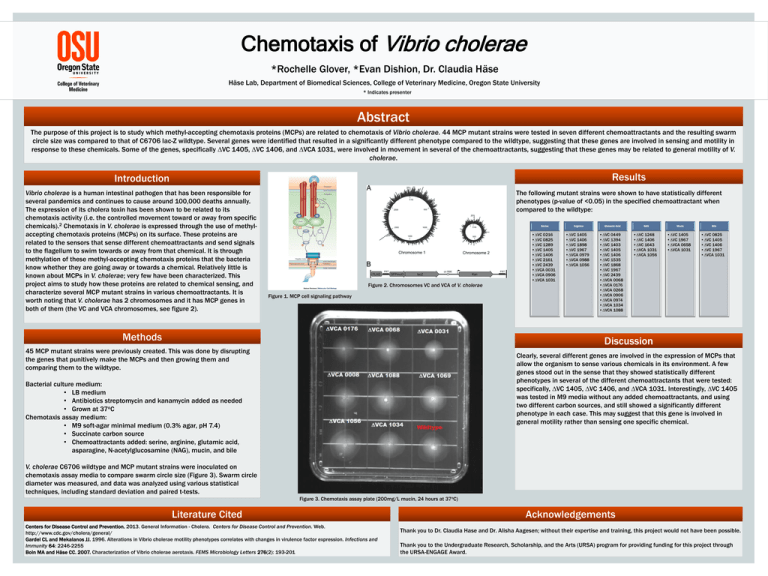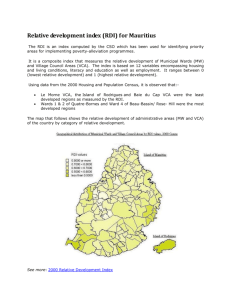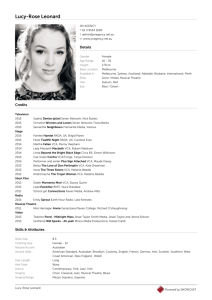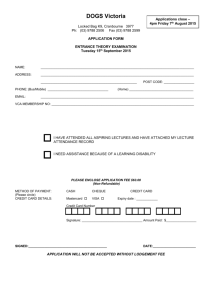Vibrio cholerae Chemotaxis of Abstract *Rochelle Glover, *Evan Dishion, Dr. Claudia Häse
advertisement

Chemotaxis of Vibrio cholerae *Rochelle Glover, *Evan Dishion, Dr. Claudia Häse Häse Lab, Department of Biomedical Sciences, College of Veterinary Medicine, Oregon State University * Indicates presenter Abstract The purpose of this project is to study which methyl-accepting chemotaxis proteins (MCPs) are related to chemotaxis of Vibrio cholerae. 44 MCP mutant strains were tested in seven different chemoattractants and the resulting swarm circle size was compared to that of C6706 lac-Z wildtype. Several genes were identified that resulted in a significantly different phenotype compared to the wildtype, suggesting that these genes are involved in sensing and motility in response to these chemicals. Some of the genes, specifically ∆VC 1405, ∆VC 1406, and ∆VCA 1031, were involved in movement in several of the chemoattractants, suggesting that these genes may be related to general motility of V. cholerae. Results Introduction Vibrio cholerae is a human intestinal pathogen that has been responsible for several pandemics and continues to cause around 100,000 deaths annually. The expression of its cholera toxin has been shown to be related to its chemotaxis activity (i.e. the controlled movement toward or away from specific chemicals).2 Chemotaxis in V. cholerae is expressed through the use of methylaccepting chemotaxis proteins (MCPs) on its surface. These proteins are related to the sensors that sense different chemoattractants and send signals to the flagellum to swim towards or away from that chemical. It is through methylation of these methyl-accepting chemotaxis proteins that the bacteria know whether they are going away or towards a chemical. Relatively little is known about MCPs in V. cholerae; very few have been characterized. This project aims to study how these proteins are related to chemical sensing, and characterize several MCP mutant strains in various chemoattractants. It is worth noting that V. cholerae has 2 chromosomes and it has MCP genes in both of them (the VC and VCA chromosomes, see figure 2). The following mutant strains were shown to have statistically different phenotypes (p-value of <0.05) in the specified chemoattractant when compared to the wildtype: Serine Figure 2. Chromosomes VC and VCA of V. cholerae Figure 1. MCP cell signaling pathway Methods •∆VC 0216 •∆VC 0825 •∆VC 1289 •∆VC 1405 •∆VC 1406 •∆VC 2161 •∆VC 2439 •∆VCA 0031 •∆VCA 0906 •∆VCA 1031 Arginine •∆VC 1405 •∆VC 1406 •∆VC 1898 •∆VC 1967 •∆VCA 0979 •∆VCA 0988 •∆VCA 1056 Glutamic Acid •∆VC 0449 •∆VC 1394 •∆VC 1403 •∆VC 1405 •∆VC 1406 •∆VC 1535 •∆VC 1868 •∆VC 1967 •∆VC 2439 •∆VCA 0068 •∆VCA 0176 •∆VCA 0268 •∆VCA 0906 •∆VCA 0974 •∆VCA 1034 •∆VCA 1088 NAG •∆VC 1248 •∆VC 1406 •∆VC 1643 •∆VCA 1031 •∆VCA 1056 Mucin •∆VC 1405 •∆VC 1967 •∆VCA 0658 •∆VCA 1031 Bile •∆VC 0825 •∆VC 1405 •∆VC 1406 •∆VC 1967 •∆VCA 1031 Discussion 45 MCP mutant strains were previously created. This was done by disrupting the genes that punitively make the MCPs and then growing them and comparing them to the wildtype. Clearly, several different genes are involved in the expression of MCPs that allow the organism to sense various chemicals in its environment. A few genes stood out in the sense that they showed statistically different phenotypes in several of the different chemoattractants that were tested: specifically, ∆VC 1405, ∆VC 1406, and ∆VCA 1031. Interestingly, ∆VC 1405 was tested in M9 media without any added chemoattractants, and using two different carbon sources, and still showed a significantly different phenotype in each case. This may suggest that this gene is involved in general motility rather than sensing one specific chemical. Bacterial culture medium: • LB medium • Antibiotics streptomycin and kanamycin added as needed • Grown at 37oC Chemotaxis assay medium: • M9 soft-agar minimal medium (0.3% agar, pH 7.4) • Succinate carbon source • Chemoattractants added: serine, arginine, glutamic acid, asparagine, N-acetylglucosamine (NAG), mucin, and bile V. cholerae C6706 wildtype and MCP mutant strains were inoculated on chemotaxis assay media to compare swarm circle size (Figure 3). Swarm circle diameter was measured, and data was analyzed using various statistical techniques, including standard deviation and paired t-tests. Figure 3. Chemotaxis assay plate (200mg/L mucin, 24 hours at 37oC) Literature Cited Centers for Disease Control and Prevention. 2013. General Information - Cholera. Centers for Disease Control and Prevention. Web. http://www.cdc.gov/cholera/general/ Gardel CL and Mekalanos JJ. 1996. Alterations in Vibrio cholerae motility phenotypes correlates with changes in virulence factor expression. Infections and Immunity 64: 2246-2255 Boin MA and Häse CC. 2007. Characterization of Vibrio cholerae aerotaxis. FEMS Microbiology Letters 276(2): 193-201 Acknowledgements Thank you to Dr. Claudia Hase and Dr. Alisha Aagesen; without their expertise and training, this project would not have been possible. Thank you to the Undergraduate Research, Scholarship, and the Arts (URSA) program for providing funding for this project through the URSA-ENGAGE Award.


